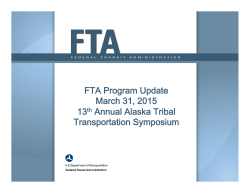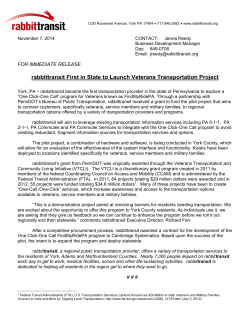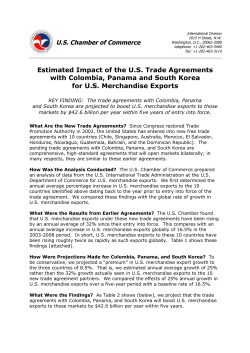
- Business Roundtable
Benefits of Trade & U.S. Trade Agreements: Drivers of American Growth & Jobs April 2015 OVERVIEW • The U.S. economy has become more dependent on internaGonal trade as a source of growth and job creaGon, with trade now supporGng more than one in five American jobs. • Trade agreements, and in parGcular the 14 current U.S. free trade agreements (FTAs) with 20 countries, have contributed importantly to U.S. growth, compeGGveness and jobs. • Trade agreements, especially FTAs, have also helped put in place strong, enforceable, and fair rules governing trade in services, manufactured goods, and agricultural products, and promoGng innovaGon and stronger protecGon for intellectual property rights. • Future customers and sales growth for American companies and their workers lie primarily outside the United States. To take fullest advantage of these important new markets, we need to complete more trade agreements, including FTAs, with other key trading partners. 2 BENEFITS OF TRADE 3 Benefits of U.S. Trade: Key Facts 1 in 5 American jobs supported by trade in 2013.1 $300 billion 47% share of U.S. goods exports that go to the naGon’s FTA partners.3 96% share of the world’s popula>on outside the U.S. 5 15-‐20% average wage premium of U.S. jobs linked to the export of goods and services.7 U.S. output generated from the naGon’s FTAs in 2008.2 59% share of imports used to produce U.S. finished products.4 3.5x U.S. trade-‐related job growth compared to total job growth from 2004-‐13.6 12.9x more U.S. goods per capita purchased by FTA partners than non-‐FTA countries in 2014.8 4 During the past half century, the U.S. economy has become more dependent on internaGonal trade as a source of economic acGvity. U.S. Trade Intensity Total Value of Traded Goods & Services as a Share of Gross Domes<c Product 35% 30% Exports Imports 25% 20% 15% 10% 5% 0% Source: Bureau of Economic Analysis, NaGonal Income & Product Accounts, Table 1.1.5 5 As trade has grown, so has the number of U.S. jobs supported by trade. Total U.S. Jobs Supported by Trade Percentage of All U.S. Jobs 1992 10.4% = 14.5 Million Jobs 2013 21.9% = 39.8 Million Jobs • In the past two decades, the United States has implemented a long series of trade agreements to help American companies, workers, and farmers compete in world markets. The resulGng explosion of trade helped double the share of total American jobs supported by trade. • By 2013, nearly 40 million jobs in America — more than one in five — depended on U.S. exports and imports. This represents 25 million more trade-‐related jobs for U.S. workers than two decades ago. • Exports support high-‐paying jobs. PosiGons linked to the export of goods and services pay on average 15-‐20 percent more than other jobs.9 Source: Laura M. Baughman and Joseph F. Francois, “Trade and American Jobs, The Impact of Trade on U.S. and State-‐Level Employment: 2014 Update,” prepared for the Business Roundtable, October 2014. 6 Access to internaGonal markets is parGcularly important to American small businesses. Companies Engaged in InternaGonal Trade, 2012* 350,000 Small Businesses Large Businesses 300,000 250,000 200,000 150,000 100,000 50,000 0 Exporters Importers *Small businesses are defined as those with fewer than 500 employees; large businesses as those with 500 or more employees. Source: U.S. Census Bureau 7 While the United States will remain an important market, growth in other countries will be the key driver of global growth. World GDP Based on Purchasing-‐Power-‐Parity (PPP) ValuaGon of Country GDP* Trillion U.S. Dollars $140 Rest of the World United States $120 $100 $80 $60 $40 $20 $0 1980 1983 1986 1989 1992 1995 1998 2001 2004 2007 2010 2013 2016 2019 *Purchasing-‐Power-‐Parity (PPP) is used to account for the fact that idenGcal goods and services can cost different amounts in different countries, so comparisons can be made across countries. Source: InternaGonal Monetary Fund, World Economic Outlook (October 2014) 8 BENEFITS OF U.S. TRADE AGREEMENTS 9 U.S. Presidents on both sides of the aisle have long recognized that internaGonal trade is criGcal to American economic growth and job creaGon. What American Presidents Have Said About Trade “Our basic trade policy remains the same: We remain opposed as ever to protec<onism, because America’s growth and future depend on trade. But we would insist on trade that is fair and free. We are always willing to be trade partners but never trade patsies.” President Ronald Reagan State of the Union Address, 1987 “Standing as we are on the edge of a new century, we know that economic growth depends as never before on opening new markets overseas and expanding the volume of world trade.” President William J. Clinton State of the Union Address, 1993 “Keeping America compe<<ve requires us to open more markets for all that Americans make and grow…and we want people everywhere to buy American. With open markets and a level playing field, no one can out produce or out compete the American worker.” President George W. Bush State of the Union Address, 2006 “We have to seek new markets aggressively, just as our compe<tors are. If America sits on the sidelines while other na<ons sign trade deals, we will lose the chance to create jobs on our shores.” President Barack Obama State of the Union Address, 2010 10 Consequently, the U.S. now has FTAs with many valued trading partners, and is pursuing sGll more. Israel Colombia Costa Rica Australia Oman Morocco Peru South Korea Panama European Union Jordan (28 Countries) 1985 1988 1991 1994 1997 2000 Chile Canada Mexico 2003 2006 2009 2012 Dominican Republic Singapore Trans-‐Pacific Partnership Bahrain Guatemala Honduras Nicaragua El Salvador Source: Office of the U.S. Trade RepresentaGve 11 Our 20 FTA partner countries are growing markets for U.S. exports. FTAs: Key to Expanding U.S. Exports FTA Partner Country Israel Canada Mexico Jordan Chile Singapore Australia Morocco El Salvador Honduras Nicaragua Guatemala Bahrain Dominican Republic Costa Rica Oman Peru South Korea Colombia Panama Entry into Force Date September 1, 1985 January 1, 1994 January 1, 1994 December 17, 2001 January 1, 2004 January 1, 2004 January 1, 2005 January 1, 2005 March 1, 2006 April 1, 2006 April 1, 2006 July 1, 2006 August 1, 2006 March 1, 2007 January 1, 2009 January 1, 2009 February 1, 2009 March 15, 2012 May 15, 2012 October 31, 2012 2014 U.S. Goods Export Growth Exports ($Mill) Since Entry* $15,074 484% $312,125 211% $240,326 478% $2,052 505% $16,630 513% $30,532 84% $26,668 91% $2,068 315% $3,347 80% $5,932 82% $1,014 62% $6,057 114% $1,060 202% $7,955 49% $7,026 24% $2,014 46% $10,070 63% $44,544 2% $20,317 42% $10,398 6% Source: U.S. Census Bureau *Growth between the last full year preceding implementaGon and 2014, except Israel, Jordan, and Panama, which are based on growth between year of implementaGon and 2014 because of late entry into force. 12 FTA partners purchase hundreds of billions of dollars in American goods, supporGng a wide range of U.S. manufacturing industries. U.S. Goods Exports to FTA Partners, Top 7 Industries Billion U.S. Dollars, 2014 Petroleum & Coal Products $67.7 Motor Vehicle Parts $41.2 Motor Vehicles $36.3 Computer Equipment $30.1 Basic Chemicals $27.0 Aerospace Products & Parts $26.8 Oil & Gas Source: U.S. Census Bureau $23.7 U.S. Goods Exports, 2014 Rest of the World (53%) FTA Partners (47%) $765 billion 2014 FTA Total Goods Exports 13 FTA partners purchase services from a wide range of U.S.-‐based services industries. U.S. Services Exports to FTA Partners, Top 7 Industries Billion U.S. Dollars, 2013* Travel & Tourism $41.8 Financial Services $13.2 U.S. Services Exports, 2013 Passenger Fares $9.8 RoyalGes from Industrial Processes Computer Sopware Management & ConsulGng Services Freight & Port Services $9.3 $8.8 FTA Partners (22.2%) Rest of the World (77.8%) $6.3 $6.0 $153+ billion* 2013 FTA Total Service Exports *Total services exports to FTA partners are understated because the U.S. government reports services data for some, but not all, FTA partners. This page reflects exports only to FTA partners for which services data are available. Source: U.S. Bureau of Economic Analysis 14 Every state has benefited from our FTAs. FTA partners account for more than 40% of goods exports in about two-‐thirds of all states. Share of Goods Exports Going to FTA Partners by State, 2014 Less than 20% 20% -‐ 30% 30% -‐ 40% 40% -‐ 50% 50% -‐ 60% More than 60% Source: The Trade Partnership 15 FTA partners spend more of their income on American-‐made goods than other countries do. Purchases of U.S. Goods as a Share of GDP Percent, 2013 20% Other Countries FTA Partners 18% 16% 14% 12% 10% 8% World Average = 2.1% of GDP 6% 4% 2% 0% India China Source: U.S. Census Bureau; World Bank Japan EU Brazil Chile Singapore DR-‐CAFTA Canada Mexico 16 DraY: Do Not Quote or Cite Conclusion • U.S. economic growth and job creaGon depend on expanding U.S. trade and investment opportuniGes so U.S. companies can sell more American products and services to customers around the world. • Trade agreements, and FTAs in parGcular, have been instrumental in giving U.S. companies and workers improved access to rapidly-‐growing markets abroad. American economic and job growth will benefit if we complete more trade agreements. • The United States is negoGaGng several major trade agreements, including the Trans-‐ Pacific Partnership, the TransatlanGc Trade and Investment Partnership, and the Trade in Services Agreement. • Congressional passage of Trade PromoGon Authority is important for advancing pending and future U.S. trade agreements to open addiGonal foreign markets to U.S. goods and services and to further support U.S. economic growth and jobs. 17 Endnotes 1 Laura M. Baughman and Joseph F. Francois, “Trade and American Jobs, The Impact of Trade on U.S. and State-‐Level Employment: 2014 Update,” prepared for the Business Roundtable, October 2014. 2 Laura M. Baughman and Joseph F. Francois, “Opening Markets and CreaGng Jobs: EsGmated U.S. Employment Effects of Trade with FTA Partners,” prepared for the U.S. Chamber of Commerce, May 2010. 3 U.S. Goods Exports to FTA Partners – Derived from U.S. Census Bureau total merchandise exports data. 4 Imports Used for U.S. ProducGon – Derived from U.S. Census Bureau end-‐use, merchandise imports data. 5 World Bank, “2014 World Development Indicators,” Table 2.1 PopulaGon Dynamics, January 2015. 6 Laura M. Baughman and Joseph F. Francois, “Trade and American Jobs, The Impact of Trade on U.S. and State-‐Level Employment: 2014 Update,” prepared for the Business Roundtable, October 2014. 7 Chris Rasmussen and MarGn Johnson, “Jobs Supported by Exports, 1993-‐2011,” U.S. Commerce Department’s Office of InternaGonal Trade AdministraGon, October 2012. 8 U.S. Goods Exports to FTA and Non-‐FTA Partners – Derived from U.S. Census Bureau total merchandise exports data. 9 Chris Rasmussen and MarGn Johnson, “Jobs Supported by Exports, 1993-‐2011,” U.S. Commerce Department’s Office of InternaGonal Trade AdministraGon, October 2012. 18 About Business Roundtable Business Roundtable's CEO members lead companies with $7.2 trillion in annual revenues and nearly 16 million employees. BRT member companies comprise more than a quarter of the total market capitalizaGon of U.S. stock markets and invest $190 billion annually in research and development – equal to 70 percent of U.S. private R&D spending. Our companies pay more than $230 billion in dividends to shareholders and generate more than $470 billion in sales for small and medium-‐sized businesses annually. BRT companies also make more than $3 billion a year in charitable contribuGons. Please visit us at www.brt.org. General Informa>on Business Roundtable Staff Contact Business Roundtable 300 New Jersey Avenue, NW, Suite 800 Washington DC 20001 Phone: 202-‐872-‐1260 David Thomas Vice President, Business Roundtable Phone: 202-‐496-‐3262 Email: dthomas@brt.org 19
© Copyright 2025
















